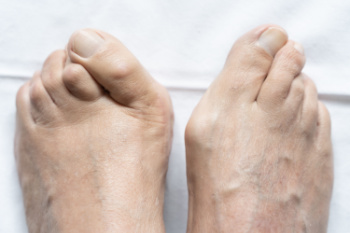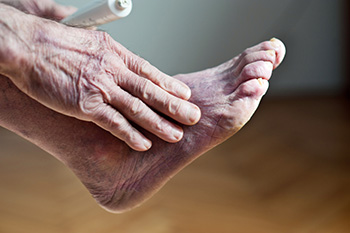Connect With Us
Blog
Items filtered by date: May 2025
Plantar Warts Can Be Treated!
What to Know About Bunions

A bunion is a bony bump that forms at the base of the big toe, causing the joint to stick out and often push the toe inward. This condition develops slowly over time and may be caused by inherited foot structure, arthritis, or wearing tight, narrow shoes. Bunions can lead to pain, swelling, and difficulty finding comfortable footwear. The skin over the bunion may become red or irritated, especially after long periods of walking or standing. Wearing shoes with a wide toe box or using padding can help manage symptoms. In more advanced cases, custom orthotics or surgery may be recommended to correct the deformity. Early attention is key to preventing the bunion from worsening. If you have a painful bump on the side of your big toe or notice changes in the shape of your foot, it is suggested that you see a podiatrist for an evaluation and treatment options.
If you are suffering from bunions, contact one of our podiatrists of Advanced Foot and Ankle Centers, Inc.. Our doctors can provide the care you need to keep you pain-free and on your feet.
What Is a Bunion?
A bunion is formed of swollen tissue or an enlargement of boney growth, usually located at the base joint of the toe that connects to the foot. The swelling occurs due to the bones in the big toe shifting inward, which impacts the other toes of the foot. This causes the area around the base of the big toe to become inflamed and painful.
Why Do Bunions Form?
Genetics – Susceptibility to bunions are often hereditary
Stress on the feet – Poorly fitted and uncomfortable footwear that places stress on feet, such as heels, can worsen existing bunions
How Are Bunions Diagnosed?
Doctors often perform two tests – blood tests and x-rays – when trying to diagnose bunions, especially in the early stages of development. Blood tests help determine if the foot pain is being caused by something else, such as arthritis, while x-rays provide a clear picture of your bone structure to your doctor.
How Are Bunions Treated?
- Refrain from wearing heels or similar shoes that cause discomfort
- Select wider shoes that can provide more comfort and reduce pain
- Anti-inflammatory and pain management drugs
- Orthotics or foot inserts
- Surgery
If you have any questions, please feel free to contact our offices located in Clovis and Madera, CA . We offer the newest diagnostic and treatment technologies for all your foot care needs.
Definition and Causes of an Ankle Fracture

An ankle fracture is a break in one or more bones that form the ankle joint. The ankle consists of the tibia, fibula, and talus. These bones come together to form a stable joint that allows the foot to move up, down, and side to side. Ligaments surrounding the joint help maintain its stability. An ankle fracture can range from a small crack to a complete break that may shift the bones out of place. Common causes include sudden twisting movements, falls, sports injuries, or car accidents. The injury may cause swelling, bruising, pain, and difficulty bearing weight. If you believe you have fractured your ankle, it is strongly suggested that you contact a podiatrist who can accurately diagnose and treat broken ankles.
Broken ankles need immediate treatment. If you are seeking treatment, contact one of our podiatrists from Advanced Foot and Ankle Centers, Inc.. Our doctors can provide the care you need to keep you pain-free and on your feet.
Broken Ankles
A broken ankle is experienced when a person fractures their tibia or fibula in the lower leg and ankle area. Both of these bones are attached at the bottom of the leg and combine to form what we know to be our ankle.
When a physician is referring to a break of the ankle, he or she is usually referring to a break in the area where the tibia and fibula are joined to create our ankle joint. Ankles are more prone to fractures because the ankle is an area that suffers a lot of pressure and stress. There are some obvious signs when a person experiences a fractured ankle, and the following symptoms may be present.
Symptoms of a Fractured Ankle
- Excessive pain when the area is touched or when any pressure is placed on the ankle
- Swelling around the area
- Bruising of the area
- Area appears to be deformed
If you suspect an ankle fracture, it is recommended to seek treatment as soon as possible. The sooner you have your podiatrist diagnose the fracture, the quicker you’ll be on the way towards recovery.
If you have any questions, please feel free to contact our offices located in Clovis and Madera, CA . We offer the newest diagnostic and treatment technologies for all your foot care needs.
Plantar Warts in Children

Plantar warts are common in children and are caused by the human papillomavirus, or HPV, which thrives in warm, moist environments like public swimming pool areas, locker rooms, and public shower areas. The virus enters the skin through tiny cuts or abrasions on the soles of the feet. Symptoms include small, rough growths on the bottom of the feet, usually on weight-bearing areas like the heels or balls of the feet. These warts may cause pain or tenderness when walking or standing, often feeling like a pebble stuck in the shoe. A podiatrist can help diagnose and treat plantar warts with various methods, including topical treatments and cryotherapy, which involves freezing the wart, for more stubborn cases. It is important to treat warts early to prevent them from spreading. To prevent plantar warts, children should wear protective footwear in public areas and avoid sharing shoes or socks. Keeping feet clean and dry also helps reduce the risk. If your child is dealing with this condition, it is suggested that you schedule an appointment to see a podiatrist.
Plantar warts can be very uncomfortable. If you need your feet checked, contact one of our podiatrists from Advanced Foot and Ankle Centers, Inc.. Our doctors will assist you with all of your foot and ankle needs.
About Plantar Warts
Plantar warts are the result of HPV, or human papillomavirus, getting into open wounds on the feet. They are mostly found on the heels or balls of the feet.
While plantar warts are generally harmless, those experiencing excessive pain or those suffering from diabetes or a compromised immune system require immediate medical care. Plantar warts are easily diagnosed, usually through scraping off a bit of rough skin or by getting a biopsy.
Symptoms
- Lesions on the bottom of your feet, usually rough and grainy
- Hard or thick callused spots
- Wart seeds, which are small clotted blood vessels that look like little black spots
- Pain, discomfort, or tenderness of your feet when walking or standing
Treatment
- Freezing
- Electric tool removal
- Laser Treatment
- Topical Creams (prescription only)
- Over-the-counter medications
To help prevent developing plantar warts, avoid walking barefoot over abrasive surfaces that can cause cuts or wounds for HPV to get into. Avoiding direct contact with other warts, as well as not picking or rubbing existing warts, can help prevent the further spread of plantar warts. However, if you think you have developed plantar warts, speak to your podiatrist. He or she can diagnose the warts on your feet and recommend the appropriate treatment options.
If you have any questions, please feel free to contact our offices located in Clovis and Madera, CA . We offer the newest diagnostic and treatment technologies for all your foot care needs.
Signs of Poor Circulation in the Feet

Poor circulation in the feet may signal an underlying medical condition that limits blood flow to the lower extremities. This issue is often seen in people with diabetes, high blood pressure, or peripheral artery disease. Symptoms of poor circulation may include cold feet, numbness, slow-healing wounds, skin discoloration, or a diminished pulse in the feet or ankles. In severe cases, poor circulation may cause muscle cramps, skin ulcers, or tissue damage due to reduced oxygen delivery. A podiatrist can perform a thorough vascular assessment and may recommend diagnostic imaging to evaluate blood flow in the feet and ankles. Medical treatment may involve prescription medication to reduce clotting, or lower cholesterol and blood pressure. In cases where arteries are blocked, surgery may be considered to restore blood flow. Addressing the root cause early can prevent serious complications like infection or gangrene. A podiatrist can also monitor your foot health over time to reduce the risk of long-term damage. If you have symptoms of poor circulation in the feet, it is suggested that you schedule an appointment with a podiatrist for an exam and appropriate treatment options.
Poor circulation is a serious condition and needs immediate medical attention. If you have any concerns with poor circulation in your feet contact one of our podiatrists of Advanced Foot and Ankle Centers, Inc.. Our doctors will treat your foot and ankle needs.
Poor Circulation in the Feet
Poor blood circulation in the feet and legs is can be caused by peripheral artery disease (PAD), which is the result of a buildup of plaque in the arteries.
Plaque buildup or atherosclerosis results from excess calcium and cholesterol in the bloodstream. This can restrict the amount of blood which can flow through the arteries. Poor blood circulation in the feet and legs are sometimes caused by inflammation in the blood vessels, known as vasculitis.
Causes
Lack of oxygen and oxygen from poor blood circulation restricts muscle growth and development. It can also cause:
- Muscle pain, stiffness, or weakness
- Numbness or cramping in the legs
- Skin discoloration
- Slower nail & hair growth
- Erectile dysfunction
Those who have diabetes or smoke are at greatest risk for poor circulation, as are those who are over 50. If you have poor circulation in the feet and legs it may be caused by PAD and is important to make changes to your lifestyle in order to reduce risk of getting a heart attack or stroke. Exercise and maintaining a healthy lifestyle will dramatically improve conditions.
As always, see a podiatrist as he or she will assist in finding a regimen that suits you. A podiatrist can also prescribe you any needed medication.
If you have any questions, please feel free to contact our offices located in Clovis and Madera, CA . We offer the newest diagnostic and treatment technologies for all your foot care needs.

